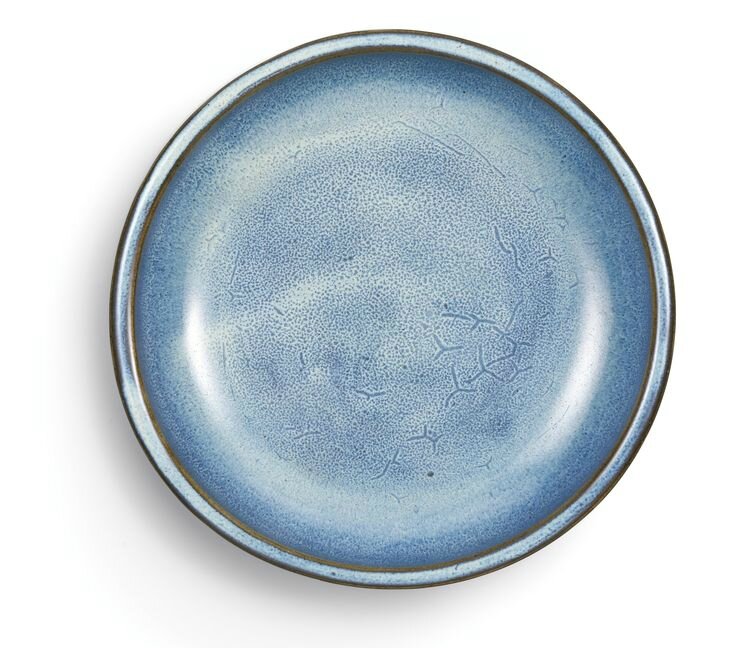A fine and brilliantly splashed lavender-glazed 'Jun' narcissus bowl, Early Ming dynasty
Lot 3602. A fine and brilliantly splashed lavender-glazed 'Jun' narcissus bowl, Early Ming dynasty. Estimation 8,000,000 — 12,000,000 HKD (933,753 - 1,400,630 EUR). Unsold. Photo Sotheby's.
of circular section with shallow rounded sides resting on three bold ruyi-head bracket feet, the outer rim moulded with two thin raised fillets enclosing a band of evenly spaced drum-nail bosses, above a row of subtle bosses encircling the base above the feet, covered in a lustrous sky-blue glaze suffused with a network of 'worm trails', the base and protruding fillets and bosses of a mushroom colour, the base incised si ('four') surrounded by a ring of spur marks, wood stand; 20 cm., 7 7/8 in.
Provenance: Christie's Hong Kong, 25th October 1993, lot 705.
Sotheby's New York, 18th March 2008, lot 100.
Notes: 'Jun' ware derives its beauty from the striking and thick opaque glaze of varied bright blue colouration that becomes almost translucent around the rim and the edges of the vessel, where the glaze thins significantly. Although 'Jun' wares are known as one of the five 'classic wares' of the Song period, mould-made flower vessels, such as the present narcissus bowl, are now overwhelmingly attributed both by Chinese and Western scholars to the types made at Yuzhou, Henan province, an area formerly known as Junzhou, from the Jin (1115-1234), Yuan (1279-1368) or the Ming period onwards. Regina Krahl in Chinese Ceramics from the Meiyintang Collection, vol. 3, pt. II, London, 2006, p. 456, notes that 'Jun' is not mentioned in any pre-Ming text, and although it was later ranked among the five 'classic wares' of the Song, the exact identity of Song 'Jun' is still a matter of debate. It was a ware that seems to have appealed particularly to the elite from the Jin Dynasty onwards, when some of the most spectacular and complex pieces were being made.
The present narcissus bowl is arguably one of the finest examples of 'Jun' vessels of this type. It is covered with an especially thick and rich opaque blue glaze of striking blue colouration that characteristically pools forming a prominent edge below the 'drum-nail' bosses around the rim and the base. Although the glaze is of an unusually rich texture it is expertly applied to expose the moulded decoration. It is comparable to a narcissus bowl with sky-blue glaze and the numeral yi (‘one’) in the Qing court collection, included in the exhibition catalogue Selection of Jun Ware. The Palace Museum's Collection and Archaeological Excavation, Palace Museum, Beijing, 2013, cat. no. 115.
Mould-made vessels of this type are frequently identified with numbers from one to ten on the base. The significance of the numbers inscribed on the vessels remains an enigma. The numbers coincide roughly with different sizes, yi ('one') being the largest and shi ('ten') the smallest version of the shape. This would help to match sets of flower pots and their stands but does not explain the appearance of numbers on the base of vases and bulb bowls, as seen on the present bowl, which generally come on their own. For further information see George J. Lee, 'Numbered Chun Ware', Transactions of the Oriental Ceramic Society, vol. 21, 1945-46, p. 61, where five 'numbered Jun' vessels from the collection of Ernest B. and Helen Pratt Dane, possibly one of the most important collectors of 'numbered Jun' wares outside China, and now in the Harvard University Art Museums, Cambridge, Mass., are recorded.
Bulb bowls of this form, with the same numeral on the base, are included in the Illustrated Catalogue of Sung Dynasty Porcelain in the National Palace Museum: Ju Ware, Kuan ware, Chun Ware, Tokyo, 1973, pls. 64 and 66, both with purple splashes added to the glaze; and two blue-glazed examples inscribed with the numeral yi ('one') are illustrated ibid., pls. 65 and 67, the latter with the so-called 'moon-white' glaze. A blue-glazed bulb bowl with the numeral si ('four'), from the Reach Family Collection and the collection of Dr. W. Kilgenberg, Bonn, was included in the exhibition Chinese Art from the Reach Family Collection, Eskenazi, London, 1989, cat. no. 24, and sold in these rooms, 2nd May 2000, lot 590; and one from the collections of Harcourt Jonhstone and Enid and Brodie Lodge was sold in our London rooms in 1940 and 1972 and again in these rooms, 30th April 1996, lot 306.
A further larger blue-glazed example can be found in the Idemitsu collection, Tokyo, illustrated in Chinese Ceramics in the Idemitsu Collection, Tokyo, 1987, pl. 104; and fragments of what appears to be a slightly smaller vessel is included in the National Museum of History publication The Ancient Kilns of Henan Province, Taipei, 2002, p. 196. Compare also a slightly larger bowl, from the T.Y. Chao collection, sold in these rooms, 19th May 1987, lot 210; and a much smaller vessel inscribed with the numeral jiu ('nine') but covered with a closely related brilliant blue glaze, from the J.M. Hu Family collection, sold in these rooms, 26th March 1996, lot 154.
See a closely related lavender-glazed narcissus bowl, but incised yi ('one'), included in this sale, lot 3603.
Sotheby's. Important Chinese Art, Hong Kong, 07 oct. 2015, 02:30 PM

/https%3A%2F%2Fprofilepics.canalblog.com%2Fprofilepics%2F1%2F0%2F100183.jpg)
/https%3A%2F%2Fstorage.canalblog.com%2F03%2F02%2F119589%2F96711876_o.jpg)
/https%3A%2F%2Fstorage.canalblog.com%2F11%2F31%2F119589%2F94773502_o.jpg)
/https%3A%2F%2Fstorage.canalblog.com%2F20%2F83%2F119589%2F94772815_o.jpg)
/https%3A%2F%2Fstorage.canalblog.com%2F26%2F72%2F119589%2F75604929_o.jpg)
/https%3A%2F%2Fstorage.canalblog.com%2F59%2F60%2F119589%2F26458628_o.jpg)





/image%2F1371349%2F20240408%2Fob_9208fd_telechargement-13.jpg)
/http%3A%2F%2Fstorage.canalblog.com%2F07%2F09%2F119589%2F129760463_o.jpg)
/http%3A%2F%2Fstorage.canalblog.com%2F39%2F29%2F119589%2F129232075_o.jpg)
/http%3A%2F%2Fstorage.canalblog.com%2F77%2F10%2F119589%2F129137638_o.jpg)